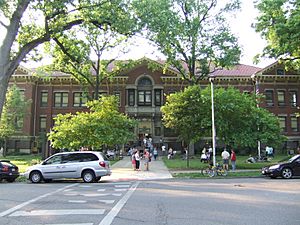Middle school facts for kids

Middle school is a special part of your education. It comes between primary school (elementary school) and secondary school (high school). People also call it intermediate school, junior high school, or lower secondary school. It's usually where students go when they are around 11 to 14 years old.
Contents
- What is Middle School?
- Middle Schools Around the World
What is Middle School?
Middle school is a stage of learning. It helps students move from primary school to high school. It's a time when you learn new subjects. You also get ready for more advanced studies.
Why Do We Have Middle Schools?
Middle schools help students grow. They focus on the needs of young teenagers. This includes how they learn and how they change. It helps them prepare for high school.
Middle Schools Around the World
Different countries have different names and systems. Let's explore how middle school works in various places.
How Does Australia Handle Middle School?
In Australia, most students go straight from primary school (Kindergarten to Year 6) to secondary school (Years 7–12). There are no separate middle schools in most states.
Some high schools have "middle school" sections. These might be for Years 5-8 or 7-9. They help students transition. In the Northern Territory, they have a three-part system. This includes middle schools for Years 7–9.
What About Middle School in Canada?
In Canada, you'll hear "middle school" and "junior high school." The grades included can change. Junior high schools often have Grades 7, 8, and sometimes 9. Middle schools are usually Grades 6–8 or 7–8. This depends on the area.
In Ontario, some schools are called "senior public schools." They usually cover Grades 7 and 8. In Quebec, there are no middle schools. Students go from Grade 6 to Secondary I (Grade 7).
How Does New Zealand Use Intermediate Schools?
In New Zealand, middle schools are called "intermediate schools." They usually cover Years 7 and 8. Students are typically 10 to 13 years old. Some primary schools also include Years 7 and 8. Some secondary schools start from Year 7.
Is There a Middle School in Spain?
Yes! In Spain, basic education is required until age 16. After primary school, students go to Educación Secundaria Obligatoria (ESO). This is like middle school and part of high school. ESO covers Grades 7 to 10. Students are usually 12 to 15 years old.
After ESO, students can choose. They can go to Bachillerato (Grades 11 and 12). Or they can choose vocational training.
What is Middle School Like in the United Kingdom?
The United Kingdom has different education systems. This depends on if you are in England, Wales, Scotland, or Northern Ireland.
Middle Schools in England and Wales
In England and Wales, middle schools were introduced in the 1960s. They were part of a "three-tier" system. This meant:
- First schools (ages 5–8)
- Middle schools (ages 8–12)
- High schools (ages 12–16)
Over time, most areas went back to a "two-tier" system. This is primary school and secondary school. Now, fewer than 150 middle schools are still open. They are either "deemed primary" or "deemed secondary." This depends on the age groups they teach.
Middle Schools in Scotland and Northern Ireland
In Scotland, some schools are called "junior high schools." These are in places like Orkney and Shetland. They teach students from age 5 up to 14. Then students move to a nearby secondary school.
In Northern Ireland, some areas use the "Dickson Plan." Students go to primary school (ages 4–10). Then they attend a junior high school (ages 11–14). After that, they go to a senior high school or grammar school.
How Do Middle Schools Work in the United States?

In the United States, middle schools are for students aged 11 to 14. They usually include Grades 6 to 8. Junior high schools are for students aged 12 to 15. They usually include Grades 7 to 9.
The idea of junior high schools started in 1909. This was in Columbus, Ohio. They were meant to help students move from elementary to high school. Over time, the "middle school" idea became more popular. It replaced most junior high schools. Middle schools focus on the unique needs of students in these grades.


